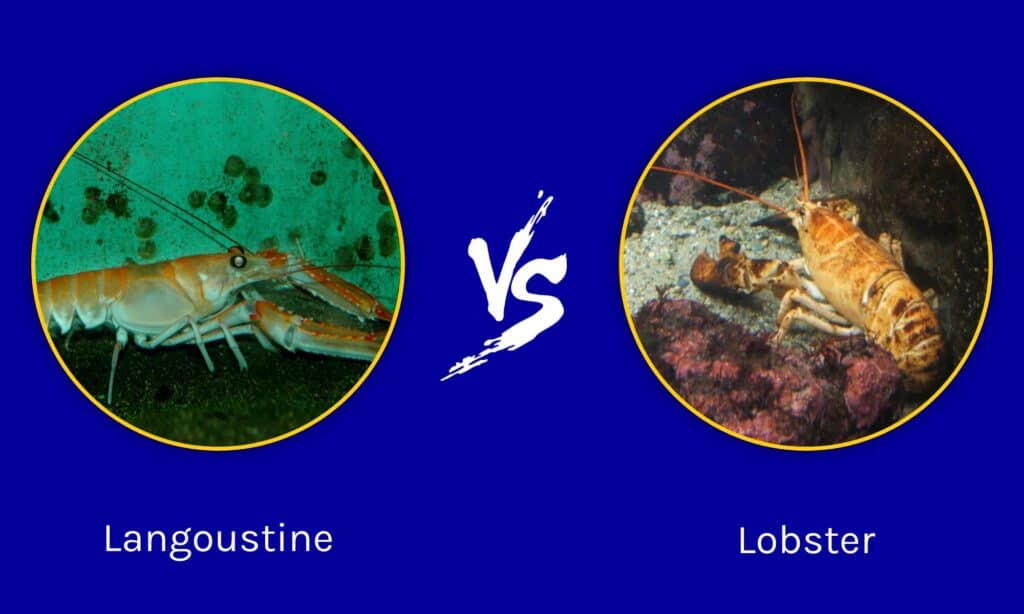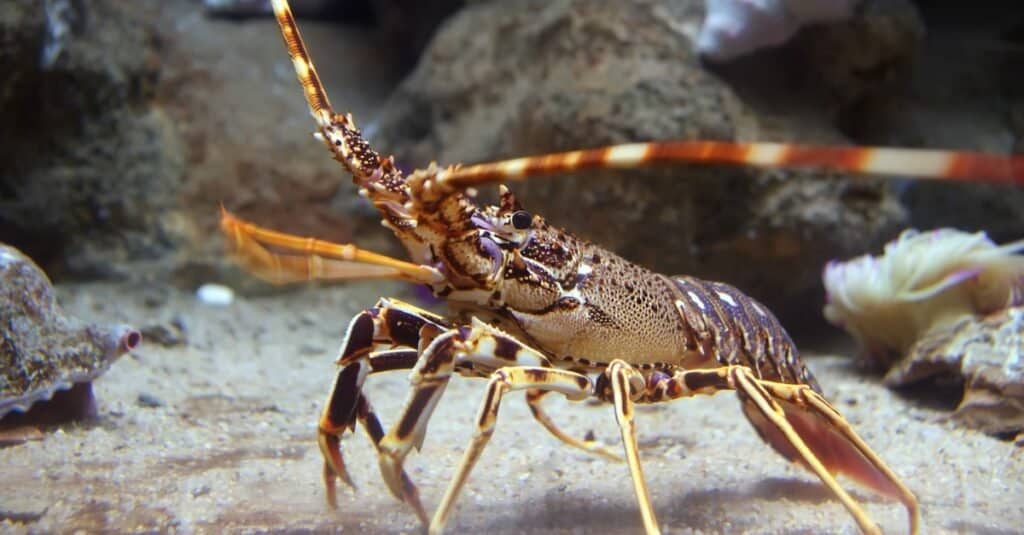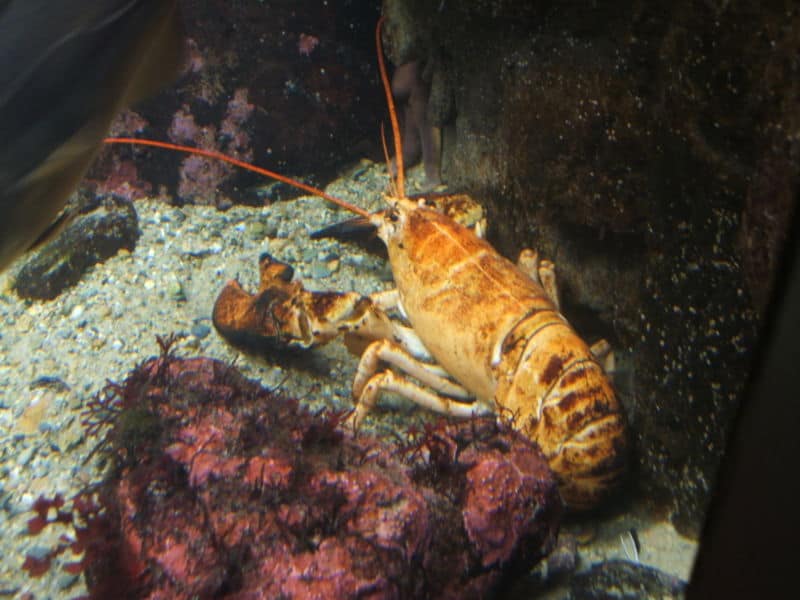Langoustines and lobsters might have a few things in common, considering they are just one type of lobster. These crustaceans are quite different from the average American lobster. Despite sporting the nickname “the Norway lobster,” a langoustine is much smaller than most lobsters. The langoustine has also been deemed the Dublin Bay prawn due to its small size. Both the langoustine and the lobster have become popular seafood delicacies and appear in cuisines worldwide.
Despite sharing some similarities, langoustines and lobsters have different appearances, lifespans, diets, habitats, and intelligence levels. In this article, we will compare the langoustine and the lobster, and take a closer look at what makes these sea creatures so different.
Comparing Langoustines and Lobsters

| Langoustine | Lobster | |
|---|---|---|
| Lifespan | 5-10 years | 20-80 years |
| Diet | Small fish, crustaceans, worms | Fish, algae, crabs, jellyfish |
| Average Length | 10 inches | 20 inches |
| Family | Malacostracans | Malacostracans |
The Key Differences Between Langoustines and Lobsters
The key differences between langoustines and lobsters are appearance, lifespan, diet, habitat, and intelligence.
Let’s talk about these differences in detail!
Langoustine vs Lobster: Appearance

Lobsters are large crustaceans that can weigh anywhere from 1 to 15 pounds.
©VLADJ55/Shutterstock.com
When it comes to the appearance of langoustines and lobsters, the main difference between them is their size. Lobsters are large crustaceans that can weigh anywhere from 1 to 15 pounds. Some have been known to get even bigger, and the heaviest lobster ever caught weighed over 44 pounds. As adults, lobsters can be anywhere from 10 to 20 inches long. Some lobsters can even reach three feet long.
Langoustines are smaller members of the lobster family. They reach an average length of 7 to 8 inches. In some cases, a langoustine may reach 10 inches long. Langoustines typically weigh less than a pound, even as adults.
Lobsters are typically depicted as red, but they are only this color after being cooked. In the wild, lobsters are a greenish-brown color, with slight variations found in different regions. The brownish color of lobster shells is an advantage that lets them camouflage on seabeds. This allows them to hide from predators, such as eels or crabs.
Langoustines are thinner than other lobster species and have a pale orange or pinkish exoskeleton. As adults, langoustines tend to be a darker orange. Broad tails allow both langoustines and lobsters to swim backward to escape predators.
Langoustine vs Lobster: Lifespan
Langoustines and lobsters have quite different lifespans. Langoustines typically live to be anywhere from 5 to 10 years old. In rare instances, they have been recorded as reaching 15 years of age.
On the other hand, lobsters can live a really long time. It is commonly stated that lobsters live forever, but that is just a myth. In reality, lobsters live between 20 to 80 years. Females are known to live longer than males, and in some rare cases, lobsters have been recorded to reach 100 years of age.
It is estimated that the oldest known lobster in the world reached 140 years old. This lobster was named George, and he was even older than the oldest recorded human, who lived to be 122. Lobsters have also been thought to be immortal due to their ability to regrow their limbs. This is done to prevent several diseases and infections and is part of why lobsters can live so old.
Langoustine vs Lobster: Diets

Langoustines have almost similar diets and eating habits to lobsters.
©Kadrina/Shutterstock.com
Langoustines and lobsters have similar diets and eating habits, but they don’t eat the same thing. Langoustines are more carnivorous than other lobster species, and they mainly prey on worms and small fish. They’ve also been known to eat jellyfish that swim nearby. Despite their small size, langoustines are pretty active predators in their habitats.
Lobsters have an omnivorous diet and a slower hunting style than langoustines. Since they tend to be slow-moving, lobsters aren’t seen as much of a predator as langoustines. They’ve been called scavengers because of their tendency to eat decaying fish matter, but they also enjoy eating fresh food. Lobsters have been nicknamed the “cockroaches of the sea” due to their ability to eat nearly anything they find.
The diets of both langoustines and lobsters include the following;
Lobsters have easily adaptable diets, which may help with their long lifespans and wide distribution.
Langoustine vs Lobster: Habitat
Langoustines and lobsters have a wide distribution around the globe, despite their preference to live solitary lives. These crustaceans can be found in every ocean, where they prefer to live along muddy or sandy floors. Despite being able to swim, langoustines and lobsters prefer crawling and will burrow in dens to rest.
Langoustines will create semi-permanent dens and prefer to only leave at night when hunting. Even when they leave to hunt or mate, they won’t stray more than 100 meters from their burrows. Langoustines can be found in the waters of Norway, Iceland, and Morocco. They prefer depths between 20 and 800 meters, with older langoustines found at deeper depths.
Lobsters are widespread across the east coast of North America. According to the University of Maine, lobsters have very minimal migratory patterns. Larger lobsters who move more might migrate into warm water during the winter, but they don’t travel too far. Just like langoustines, lobsters tend to stay in waters between 59 and 64 degrees Fahrenheit. Adult lobsters will commonly venture into the ocean’s depths, while juveniles prefer to stay near the shoreline.
Langoustine vs Lobster: Intelligence

Lobsters have good memories.
©Steven G. Johnson, CC BY-SA 3.0, via Wikimedia Commons – License
For the most part, crustaceans like crabs and langoustines aren’t considered smart, but studies have found that lobsters are quite intelligent. According to PETA, several researchers have found that lobsters can be just as smart as octopi. Lobsters are known to recognize other lobsters, have good memories, and feel pain similar to the way humans do. Lobsters have also been observed to have complex mating rituals.
The Math Instinct, published by Keith Devlin in 2009, observed the innate mathematical instincts that lobsters and other creatures have. Devlin explored the natural mathematical instincts of dogs, cats, lobsters, and even people.
While there is less research surrounding intelligence in langoustines, evidence suggests that most crustaceans and shellfish experience pain and have some level of intelligence.
The photo featured at the top of this post is © RLS Photo/Shutterstock.com
Thank you for reading! Have some feedback for us? Contact the AZ Animals editorial team.







